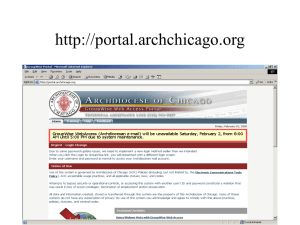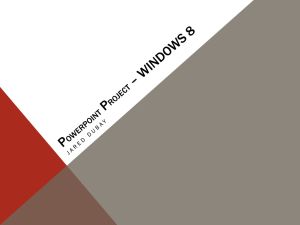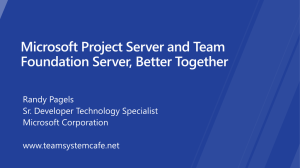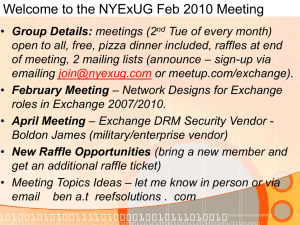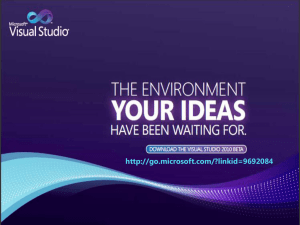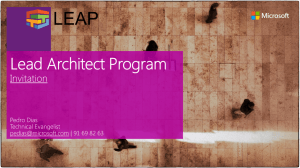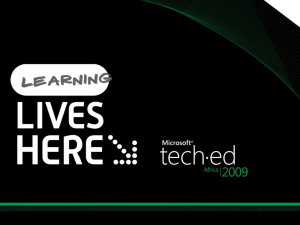Exchange 2013 Setup
advertisement
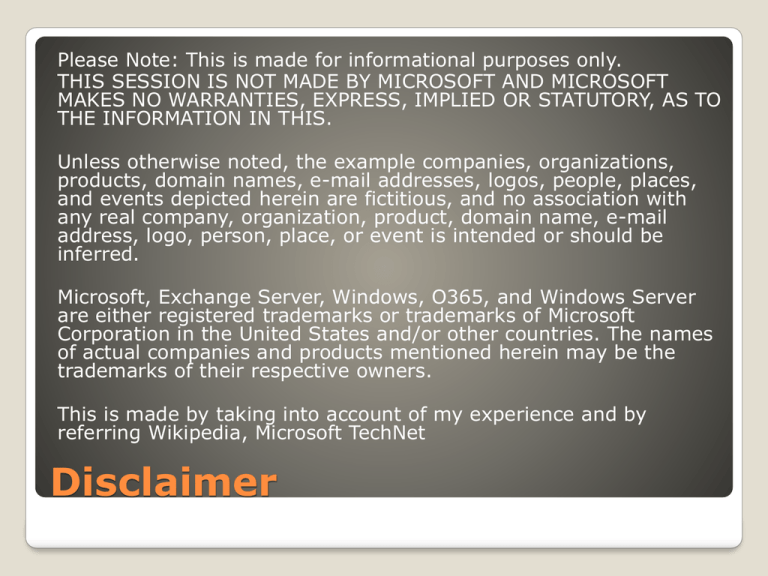
Please Note: This is made for informational purposes only. THIS SESSION IS NOT MADE BY MICROSOFT AND MICROSOFT MAKES NO WARRANTIES, EXPRESS, IMPLIED OR STATUTORY, AS TO THE INFORMATION IN THIS. Unless otherwise noted, the example companies, organizations, products, domain names, e-mail addresses, logos, people, places, and events depicted herein are fictitious, and no association with any real company, organization, product, domain name, e-mail address, logo, person, place, or event is intended or should be inferred. Microsoft, Exchange Server, Windows, O365, and Windows Server are either registered trademarks or trademarks of Microsoft Corporation in the United States and/or other countries. The names of actual companies and products mentioned herein may be the trademarks of their respective owners. This is made by taking into account of my experience and by referring Wikipedia, Microsoft TechNet Disclaimer Road2Master Microsoft Exchange Server 2013 Major changes with Exchange Server 2013 PART 2 Ashwin Venugopal www.Road2Master.ms Know the Voice An Infrastructure consultant with around 8 years of IT industry experience. I’m work on Microsoft Infrastructure related products and technologies like Active Directory, Messaging, SCCM, SCOM, Virtualization, Office 365 etc. Welcome and Introduction Major changes with Exchange Server 2013 PART 1 of 2 PART 2 of 2 ◦ ◦ ◦ ◦ ◦ ◦ ◦ ◦ ◦ Changes in Exchange Architecture What is Exchange Admin Center? Changes in Information Store Changes in Certificate Management Changes in Messaging Policy and Compliance Changes in Anti-malware protection Changes in Transport Rules Changes in Mail Flow Changes in Recipient Management ◦ ◦ ◦ ◦ ◦ ◦ ◦ ◦ Changes in Clients and Mobiles Changes in Sharing and collaboration Changes in Unified Messaging Changes in Batch mailbox moves Changes to High availability and site resilience What is Exchange workload management? Exchange 2013 Setup Finally, What’s Removed in Exchange 2013? Agenda Changes in Clients and Mobiles ◦ ActiveSync There is no new EAS version or hidden ActiveSync features in the Exchange 2013. Only difference I can find is New-ActiveSyncMailboxPolicy is replaced by NewMobileMailboxPolicy. ◦ Outlook No more MAPI No offline access to Archive Mailbox Outlook 2013 can control the size of the OST file Outlook 2013 not longer connects to Server using FQDN Outlook uses Autodiscover to create a new connection point comprised of mailbox GUID, @ symbol, and the domain portion of the user’s primary SMTP address. Major changes in Clients and Mobiles Changes in Clients and Mobiles ◦ Outlook Web App Optimized for touch devices. Apps in Outlook Web App. Apps for Outlook aren’t dependent on the version of Exchange Server that you’re using. Administrators can also allow users to download apps from Office.com. Third-party developers can create additional apps for Outlook and offer them at Office.com. ◦ Contacts a.k.a People Users can link multiple entries for the same person and view the information in a single contact card. ◦ Calendar Users can now view multiple calendars in a merged view. The month view now includes an agenda for the selected day. In all calendar views, users can click an item to view a pop-up of the item's details. The month view now includes an agenda for the selected day. In all calendar views, users can click an item to view a pop-up of the item's details. ◦ Outlook Web App Offline Does not include Archive Mailbox Still. Its still Online Archive Mailbox. Major changes in Clients and Mobiles Changes in Sharing and collaboration Site mailboxes ◦ Site mailboxes require Exchange 2013 and SharePoint Server 2013 integration and configuration. Major changes in Sharing and Collaboration Changes in Unified Messaging ◦ All the Unified Messaging components are split between Microsoft Exchange Unified Messaging Call Router service (Client Access Server Role) Microsoft Exchange Unified Messaging service (Mailbox Server Role) As in Exchange 2010, Exchange 2013 Client Access and Mailbox servers fully support IPv6 networks. In Exchange 2010 SP2 and SP1, UCMA 2.0 installation is required prior to installing the service pack on a Unified Messaging server. However, UCMA 2.0 had several limitations. UCMA 4.0 corrects many of the shortcomings. Speech-related services uses Speech Engine 11.0 and UCMA 4.0. Grammar generation and language improvements are included. Major changes in Unified Messaging Changes in Batch mailbox moves ◦ New batch move architecture features: Ability to move multiple mailboxes in large batches. Email notification during move with reporting. Automatic retry and automatic prioritization of moves. Primary and personal archive mailboxes can be moved together or separately. Option for manual move request finalization, which allows you to review a move before you complete it. Periodic incremental syncs to migrate the changes. Major changes in Batch Mailbox Moves Changes in Batch mailbox ◦ Create a local move request moves New-MoveRequest ◦ Create a batch move request New-MigrationBatch ◦ for eg. ◦ New-MigrationBatch -Local -Name LocalMove1 - CSVData ([System.IO.File]::ReadAllBytes("C:\Users\Administrato r\Desktop\LocalMove1.csv")) -TargetDatabases MBXDB2 -TimeZone "Pacific Standard Time" Start-MigrationBatch -Identity LocalMove1 Major changes in Batch Mailbox Moves Changes in Batch mailbox moves ◦ Display migration batches Get-MigrationBatch ◦ To get Migration Statistics Get-MigrationUserStatistics ◦ Move a user's primary mailbox and archive mailbox to separate databases New-MoveRequest -Identity 'Username' TargetDatabase DatabaseName1 ArchiveTargetDatabase DatabaseName2 ◦ Create a cross-forest move First configure the migration endpoint Then creates a cross-forest batch move Major changes in Batch Mailbox Moves Major changes in High availability and site resilience ◦ Exchange 2013 uses DAGs - Mailbox database copies Single item recovery Retention policies Lagged database copies ◦ Improvements Managed availability Managed Store Support for multiple databases per disk Automatic reseed Automatic recovery from storage failures Lagged copy enhancements Single copy alert enhancements DAG network auto-configuration Major changes in High Availability and Site resilience Managed availability Managed Store ◦ In this monitoring and recovery-oriented features are tightly integrated to help prevent failures ◦ Proactively restore services ◦ Initiate server failovers automatically ◦ Alert administrators to take action. ◦ The Managed Store is the name of the newly rewritten Information Store processes in Exchange 2013. Support for multiple databases per disk Automatic reseed Automatic recovery from storage failures Lagged copy enhancements Single copy alert enhancements DAG network auto-configuration ◦ Lagged copies can invoke auto replay feature when a low disk space threshold has been reached ◦ Is no longer a separate scheduled script, now a part of Managed availability Major changes in High Availability and Site resilience What is Exchange workload management? ◦ Monitor the health of system resources ◦ Control how resources are consumed by individual users First we need to create workload management policy ◦ New-WorkloadManagementPolicy Then create a new workload policy and assign it to the above new workload management policy ◦ New-WorkloadPolicy Apply the custom workload management policy to a specific server ◦ Set-ExchangeServer -WorkloadManagementPolicy Workload_Management_Policy_Name -Server ServerName Change workload management policy settings for all servers in your organization ◦ create a new workload policy and assign it to GlobalOverwrittenWorkloadManagementPolicy What is Exchange Workload Management? Exchange 2013 Setup Active Directory preparation ◦ Install the following software on the computer that will be used to prepare Active Directory: Microsoft .NET Framework 4.5 Windows Management Framework 3.0 Remote Tools Administration Pack ◦ Mailbox server role or combined Mailbox and Client Access server roles Install-WindowsFeature AS-HTTP-Activation, Desktop-Experience, NET-Framework-45Features, RPC-over-HTTP-proxy, RSAT-Clustering, RSAT-Clustering-CmdInterface, WebMgmt-Console, WAS-Process-Model, Web-Asp-Net45, Web-Basic-Auth, Web-Client-Auth, Web-Digest-Auth, Web-Dir-Browsing, Web-Dyn-Compression, Web-Http-Errors, Web-HttpLogging, Web-Http-Redirect, Web-Http-Tracing, Web-ISAPI-Ext, Web-ISAPI-Filter, Web-LgcyMgmt-Console, Web-Metabase, Web-Mgmt-Console, Web-Mgmt-Service, Web-Net-Ext45, Web-Request-Monitor, Web-Server, Web-Stat-Compression, Web-Static-Content, WebWindows-Auth, Web-WMI, Windows-Identity-Foundation ◦ Client Access server role Install-WindowsFeature AS-HTTP-Activation, Desktop-Experience, NET-Framework-45Features, RPC-over-HTTP-proxy, RSAT-Clustering, Web-Mgmt-Console, WAS-Process-Model, Web-Asp-Net45, Web-Basic-Auth, Web-Client-Auth, Web-Digest-Auth, Web-Dir-Browsing, Web-Dyn-Compression, Web-Http-Errors, Web-Http-Logging, Web-Http-Redirect, Web-HttpTracing, Web-ISAPI-Ext, Web-ISAPI-Filter, Web-Lgcy-Mgmt-Console, Web-Metabase, WebMgmt-Console, Web-Mgmt-Service, Web-Net-Ext45, Web-Request-Monitor, Web-Server, Web-Stat-Compression, Web-Static-Content, Web-Windows-Auth, Web-WMI, WindowsIdentity-Foundation Exchange 2013 Setup Exchange 2013 Setup Supported Outlook ◦ Unlike older version, Microsoft suggests installing MBX role first ◦ Forest functional level should be at least Windows Server 2003 ◦ Schema master is running Windows Server 2003 with SP1 or later ◦ Outlook 2013 Preview ◦ Outlook 2010 SP1 with April 2012 Cumulative Update ◦ Outlook 2007 SP3 with July 2012 Cumulative Update ◦ Entourage 2008 for Mac, Web Services Edition ◦ Outlook for Mac 2011 Exchange 2013 Setup Exchange 2013 Setup Active Directory preparation ◦ Prepare Active Directory and Domains ◦ setup /PrepareSchema or setup /ps ◦ Sets the schema version (ms-Exch-Schema-Verision-Pt) to 15137 ◦ setup /PrepareAD [/OrganizationName:<organization name>] or setup /p [/on:<organization name>] ◦ Sets the objectVersion to 15449. ◦ CN=<your organization>,CN=Microsoft Exchange,CN=Services,CN=Configuration,DC=<domain > ◦ setup /PrepareDomain or setup /pd Exchange 2013 Setup Verify Active Directory preparation ◦ In the Configuration naming context, verify that the msExchProductId property in the CN=<your organization>,CN=Microsoft Exchange,CN=Services,CN=Configuration,DC=<domain > container is set to 15.00.516.032. ◦ In the Schema naming context, verify that the rangeUpper property on ms-Exch-Schema-Verision-Pt is set to 15137. ◦ In the Configuration naming context, verify that the objectVersion property in the CN=<your organization>,CN=Microsoft Exchange,CN=Services,CN=Configuration,DC=<domain > container is set to 15449. ◦ In the Default naming context, verify that the objectVersion property in the Microsoft Exchange System Objects container under DC=<root domain is set to 13236. Exchange 2013 Setup Verify Active Directory preparation ◦ In the Configuration naming context, verify that the msExchProductId property in the CN=<your organization>,CN=Microsoft Exchange,CN=Services,CN=Configuration,DC=<domain > container is set to 15.00.516.032. ◦ In the Schema naming context, verify that the rangeUpper property on ms-Exch-Schema-Verision-Pt is set to 15137. ◦ In the Configuration naming context, verify that the objectVersion property in the CN=<your organization>,CN=Microsoft Exchange,CN=Services,CN=Configuration,DC=<domain > container is set to 15449. ◦ In the Default naming context, verify that the objectVersion property in the Microsoft Exchange System Objects container under DC=<root domain is set to 13236. Exchange 2013 Setup Setup ◦ GUI Please refer the below links. http://exifs.blogspot.in/#!/2012/07/installingexchange-server-2013-preview.html http://technet.microsoft.com/enus/library/bb124778.aspx ◦ CLI ◦ Setup.exe /mode:Install /role:ClientAccess,Mailbox /OrganizationName:MyOrg /IAcceptExchangeServerLicenseTerms ◦ Setup.exe /mode:Uninstall Exchange 2013 Setup What's Discontinued in Exchange 2013 ◦ Architecture Hub Transport server Role Unified Messaging server Role ◦ Management interfaces Exchange Management Console Exchange Control Panel ◦ Client access Outlook 2003 is no longer supported RPC/TCP access for Outlook clients What's Discontinued in Exchange 2013 Outlook Web App ◦ Access to shared email folders ◦ Distribution list moderation ◦ S/MIME Inability to apply messaging policies Antivirus software is unable to scan encrypted message content Impact to custom transport agents Taken care by Information Rights Management ◦ Spell check ◦ Reading pane at the bottom of the page ◦ Cannot reply to emails that are sent as attachments What's Discontinued in Exchange 2013 Mail flow ◦ Linked connectors ◦ Anti-spam and anti-malware ◦ Anti-spam agent management only availble in Exchange Management Shell ◦ No more Connection Filtering agent The Connection Filtering agent provides IP Allow List and IP Block List capabilities. ◦ Messaging policy and compliance ◦ Retention policies replace Managed Folders What's Discontinued in Exchange 2013 Tools ◦ ◦ ◦ ◦ ◦ Exchange Best Practice Analyzer Mail flow troubleshooter Performance monitor Performance troubleshooter Routing Log Viewer What's Discontinued in Exchange 2013 END OF PART 2 Thank you for your time Questions? Ashwin Venugopal www.Road2Master.ms Please Note: This is made for informational purposes only. THIS SESSION IS NOT MADE BY MICROSOFT AND MICROSOFT MAKES NO WARRANTIES, EXPRESS, IMPLIED OR STATUTORY, AS TO THE INFORMATION IN THIS. Unless otherwise noted, the example companies, organizations, products, domain names, e-mail addresses, logos, people, places, and events depicted herein are fictitious, and no association with any real company, organization, product, domain name, e-mail address, logo, person, place, or event is intended or should be inferred. Microsoft, Exchange Server, Windows, O365, and Windows Server are either registered trademarks or trademarks of Microsoft Corporation in the United States and/or other countries. The names of actual companies and products mentioned herein may be the trademarks of their respective owners. This is made by taking into account of my experience and by referring Wikipedia, Microsoft TechNet Disclaimer

